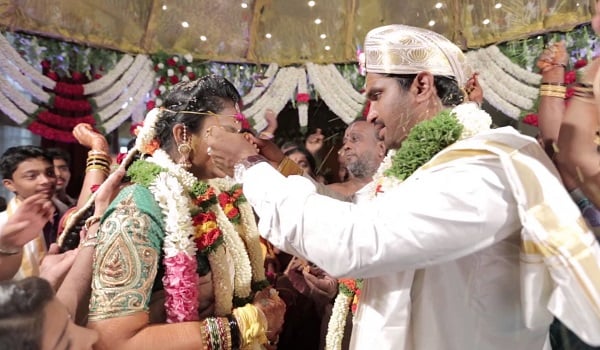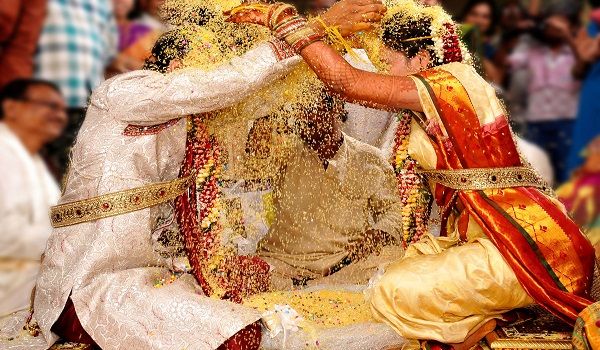Kannada Weddings are simple affairs that focuses mainly on traditional rituals and less show. Kannadigas prefer to abide by all the age-old traditions especially when it comes to weddings. While the rituals vary slightly in different regions and other communities of Karnataka, the core structure of the wedding remains the same. Kannada weddings are comparatively short and are similar to the rituals conducted in neighboring states like Maharashtra or Andhra Pradesh. In this guide, we give you the details of the South Indian Kannada wedding rituals, customs etc.
Pre-wedding Rituals
Nischay Tamulam
Just like any arranged marriage in Hinduism, the horoscope of the prospective bride and groom should match. Once the horoscope matches, an engagement day is fixed. On the engagement day, a priest is called upon where the parents of the bride and groom exchange a platter containing fruits, coconut, flowers, betel nuts, and betel leaves. This ceremony is called Nischay Tamulam. The parents of the groom visit the bride’s place and offer her a saree, blouse piece, coconut and sweets. A similar ritual is conducted where the bride’s parents visit the groom’s house and gift him dhoti, coconut, fruits and sweets.
Naandi
A few days before the wedding day, both the bride and groom’s family conducted a function called Naandi. This Puja is done by the family priest to ensure that the wedding ceremony is conducted without any obstacles. A coconut is placed in a Kalash which is filled with holy water. This marks the beginning of wedding celebrations. While the Kalash symbolizes the Nectar of Life, the ceremony makes sure that the couple is blessed with a life of wealth, health, knowledge, and longevity. After the wedding invitation is printed, the first wedding invitation is offered to the Almighty to remove any obstacles and have a successful wedding.
Kaashi Yaatra
A fun-filled ritual, this is where the groom pretends to leave for Kashi and spend his days as a monk. The groom’s maternal uncle stops him says that a girl has been chosen for him. Sometimes, it is also a custom for the maternal uncle to offer his daughter the bride for the boy. The groom concedes on hearing this offer and decides to come back home and get married to his bride.
DevKarya
On the wedding day, the groom seeks blessings from the deities. The things to be used for the wedding are kept in front of lord Ganesh to seek his blessings and to purify the objects.
Wedding Attire

The Kannadiga Groom
Kannadigas are perfectionists and stick to their tradition when it comes to wedding attire. The groom wears a white Veshti or dhoti that is worn in typical South Indian style around the waist. It is made of cotton or silk with thin ornate borders. The Dhoti is paired with a white Kurta or Sherwani. However, during the wedding rituals, the groom should wear a white silk scarf matching with his Veshti known as Angavestram. He also wears a turban known as Pheta or Pitambar, which is in orange or white color. The groom also carries a stick in his right hand. The stick is blessed by the priest in a temple before the wedding day. In the Baliga community of Karnataka, the groom wears a Veshti which is paired with Valli. He also combines it with a white shirt along with the Pheta.
The Kannadiga Bride
As the bride is bedecked with jewels, she wears a traditional nine yards long Naavari Saree. She also wears green glass bangles along with the saree. This is a similar attire to the Maharashtrian bride. The bride also wears Maang Tikka, necklaces, jhumka, and Kamarbandh. In Baliga community, the bride wears a white saree with brightly colored borders. Kannadiga brides from Coorg region wear brightly colored brocade sarees that are draped in typical Coorgi style. The bride also covers her head with a veil.
Wedding Rituals
Greeting Groom’s Party
The groom and his friends and relatives arrive at the wedding venue where they are welcomed with five Sumangalis (i.e. married women) who take turns to perform an Aarti of the groom before escorting him in.
Mandap Puja
Before any of the wedding rituals begin, the priest performs a Mandap Puja to purify the mandap and the wedding venue as well.
Var Puja
According to Hindu tradition, the groom is considered as the reincarnation of Lord Vishnu. He is welcomed to the wedding mandap by his future father-in-law and is asked to sit on a specific seat where he washes the groom’s feet. The father-in-law also presents him with a set of silk dhoti and scarf known as Pitambar. The groom should take part in the wedding rituals wearing these clothes.
Jaimala
The bride is then ushered to the wedding mandap by her friends and family. Her face is covered behind a fan that is made of peacock feathers. She is usually accompanied by her sister who holds the peacock feather’s fan to shield the bride’s face. As the bride takes her place at the Mandap, a cloth curtain is placed between the bride and groom. This is to prevent them from seeing each other. The priest recites the opening mantras of the wedding rituals. The curtain is gradually removed which enables the couple to see each other for the first time. They both exchange Jaimala three times.
Dhareherdu
This Kannada wedding ritual is similar to the Kanyadaan ceremony in Hindu weddings. The bride’s right hand is placed on the groom’s right hand along with a coconut and betel leaves. The bride’s parents give away their daughter and shower their blessings by pouring holy water called Dhara on top of the couple’s hands.
Saptapadi
The couple circumambulates the sacred fire seven times which is called Saptapadi. The bride and the groom recite the seven sacred vows of marriage and their commitment to stay with each other for the next seven lives. After the Saptapadi, the couple is asked to sit down where the groom ties the Mangalsutra around the bride’s neck. This officially concludes the wedding and the couple are declared husband and wife.
Post-wedding Rituals

Okhli
Okhli is a post-wedding game that is intended to be an icebreaker between the newlyweds and their families. The groom’s ring is dropped in a vessel containing milk. The bride and her brother need to find the ring from the vessel who are given three rounds. If the bride is successful in finding the ring, then it is believed that she can handle any challenge which marital life throws at her.
Vidaai
An emotional moment, the bride bids adieu to her family and her paternal house as she is ready to begin a new chapter in her life. The bride’s brother goes with her to her husband’s home. He stays there overnight and departs the next morning.
GrihaPravesh
The bride is given a warm welcome as she arrives at her in-law’s house. Her mother-in-law performs a welcoming Aarti and welcomes her in the house. A pot filled with rice up brim is placed on the threshold which signifies the existing wealth of the house. As the bride makes her way in, she overturns the pot with her right foot that symbolizes that her arrival has increased the prosperity of her new house resulting in the vessel overflowing.
Clothes Presentation Ceremony
The bride is gifted five sarees by her husband which she has to wear for various post-wedding rituals.
Name Change Ceremony
In this ceremony, the husband chooses a new name for his wife and writes it on a plate of rice using his ring. The bride accepts the plate of rice from him hinting that she has accepted her new name.
Visiting the Bride’s house
The bride’s parents arrive at the groom’s house on the second day of marriage and take the couple to their house where the couple stay for one night before returning to the groom’s house.
Reception
A grand reception is held by the groom’s family for friends and relatives.
This concludes the Kannada wedding rituals. A simple wedding infused with traditional rituals, Kannada wedding is a delight to watch.
